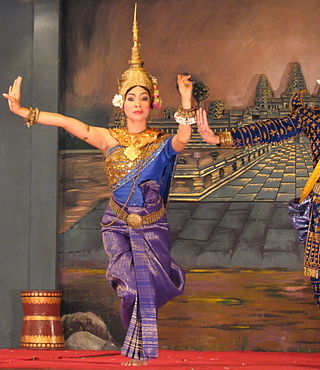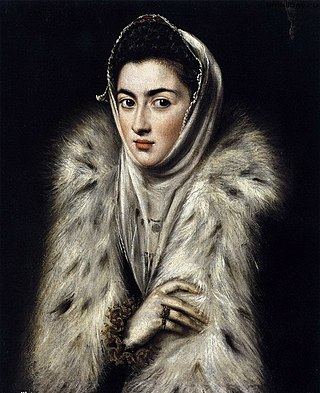
A loincloth is a one-piece garment, either wrapped around itself or kept in place by a belt. It covers the genitals and sometimes the buttocks. Loincloths which are held up by belts or strings are specifically known as breechcloth or breechclout. Often, the flaps hang down in front and back.

A skirt is the lower part of a dress or a separate outer garment that covers a person from the waist downwards.

A sari is a women's garment from the Indian subcontinent. It consists of an un-stitched stretch of woven fabric arranged over the body as a robe, with one end attached to the waist, while the other end rests over one shoulder as a stole, sometimes baring a part of the midriff. It may vary from 4.1 to 8.2 metres in length, and 60 to 120 centimetres in breadth, and is a form of ethnic wear in Bangladesh, India, Sri Lanka, Nepal, and Pakistan. There are various names and styles of sari manufacture and draping, the most common being the Nivi style. The sari is worn with a fitted bodice also called a choli and a petticoat called ghagra, parkar, or ul-pavadai. It remains fashionable in the Indian subcontinent today.

The dhoti, also known as mardani, jaiñboh, or panche, is an ankle-length breechcloth, arranged around the waist and the legs, in resemblance to the shape of trousers. The dhoti is a lower garment forming part of ethnic wear for men in the Indian subcontinent. The dhoti is fashioned out of a rectangular piece of unstitched cloth, usually around 5 yards or 4.6 metres (15 ft) long.

A sarong or a sarung is a large tube or length of fabric, often wrapped around the waist, worn in Southeast Asia, South Asia, Western Asia, Northern Africa, East Africa, West Africa, and on many Pacific islands. The fabric often employs woven plaid or checkered patterns or may be brightly colored by means of batik or ikat dyeing. Many modern sarongs have printed designs, often depicting animals or plants. Different types of sarongs are worn in different places in the world, notably the lungi in the Indian subcontinent and the izaar in the Arabian Peninsula.
South Indian culture refers to the cultural region typically covering the South Indian states of Tamil Nadu, Karnataka, Kerala, Andhra Pradesh, and Telangana. The idea of South India is closely linked to the Dravidian ethnic and linguistic identity and therefore it can also refer to groups in central India such as the Gondi and the Kui. Similar to India it is difficult to define a common essence of South Indian culture. That being some common threads include the eternal universe through the celebration of the beauty of the body and femininity. It is exemplified through its dance, clothing, and sculptures.
Clothing in India varies with the different ethnicities, geography, climate, and cultural traditions of the people of each region of India. Historically, clothing has evolved from simple garments like kaupina, langota, achkan, lungi, sari, to perform rituals and dances. In urban areas, western clothing is common and uniformly worn by people of all social levels. India also has a great diversity in terms of weaves, fibers, colors, and the material of clothing. Sometimes, color codes are followed in clothing based on the religion and ritual concerned. The clothing in India also encompasses a wide variety of Indian embroidery, prints, handwork, embellishments, and styles of wearing clothes. A wide mix of Indian traditional clothing and western styles can be seen in India.

The lungi is a clothing similar to the sarong that originated in the Indian subcontinent. The lungi, which usually multicoloured, is a men's skirt usually tied around the lower waist below the navel. It can be worn as casual wear and night wear. It is favoured in hot and humid climates where the airflow it allows makes it more comfortable than alternatives.

Tupenu is the Tongan term for a wrapped garment also called a sarong, lungi, or lava-lava, worn through much of South Asia, Southeast Asia, Arabian Peninsula, the Horn of Africa and Oceania. It is analogous to the kilt worn in Scotland.

Mundum neriyatum is the traditional clothing of women in Kerala, a state in southwestern India. It is the oldest remnant of the ancient form of the sari which covered only the lower part of the body. In the mundum neriyatum, the most basic traditional piece is the mundu or lower garment which is the ancient form of the sari denoted in Malayalam as tuṇi, while the nēriyatu forms the upper garment the mundu. The mundum neriyatum consists of two pieces of cloth, and could be worn in either the traditional style with the nēriyatu tucked inside the blouse, or in the modern style with the nēriyatu worn over the left shoulder.

A sampot, a long, rectangular cloth worn around the lower body, is a traditional dress in Cambodia. It can be draped and folded in several different ways. The traditional dress is similar to the dhoti of Southern Asia. It is also worn in the neighboring countries of Laos and Thailand where it is known as pha nung.

Pakaian is the term for clothing in Malaysia's national language. It is referring to things to wear such as shirts, pants, shoes etc. Since Malaysia is a multicultural nation: Malay, Chinese, Indian and hundreds of other indigenous groups of Malay Peninsula and Borneo, each has its own traditional and religious articles of clothing all of which are gender-specific and may be adapted to local influences and conditions. Previously, traditional clothes were worn daily. However, by excluding Baju Melayu, Baju Kurung many are now only worn on special occasions such as marriage ceremonies and cultural events.

Khmer traditional clothing refers to the traditional styles of dress worn by the Khmer people throughout history. Tracing their origins back to the early Common Era, the customary styles of dress worn by Khmer people predate the indianization of Southeast Asia. The evolution of these clothing customs can be traced through archaeological artifacts from the 6th century to the post-Angkorian period, evolving from the simple pre-Angkorian Sampot to vibrant and intricately embroidered silk garments.

Kerala sari (Set-sari) is a clothing of women in the Indian state of Kerala.

The kaupinam, koavanam, kaupina, langot, or lungooty is a loincloth worn by men in the Indian subcontinent as underclothing. It is still commonly worn in South Asia by pehlwans (wrestlers) while exercising or sparring in a dangal. It is basically a rectangular strip of cloth used to cover the genitals, with strings connected to the four ends of the cloth, for binding it around the waist and between the legs.
Onnara is a traditional form of underwear for women of all ages worn among Hindu women in Kerala. Onnara is a dothi (sarong) tied in such a way that it is tight, and cannot be accidentally released.

In the context of clothing, a wrap is

The national costume of Indonesia is the national attire that represents the Republic of Indonesia. It is derived from Indonesian culture and Indonesian traditional textile traditions. Today the most widely recognized Indonesian national attires include batik and kebaya, although originally those attires mainly belong within the island of Java and Bali, most prominently within Javanese, Sundanese and Balinese culture. Since Java has been the political and population center of Indonesia, folk attire from the island has become elevated into national status.
Kasavu is a technique used in handlooms of Kerala, with very fine threads of gold or silver used in weave to make border lines and designs on silk and cotton fabrics. This technique later spread to most of India and the Kasav technique was developed for many other fabrics across India. White or off-white cotton cloth with Kasav borders that originated in the South Indian state of Kerala is now famous as Kerala saree is believed to be first form of use of Kasav technique.

Chattayum Mundum is a traditional attire used by the Syrian Christian women of Kerala. It is a seamless white garment, consisting of a white blouse covering the whole upper part of the body ("Chatta") and a long white garment called "Mundu" which is wrapped around the waist which reaches to the ankles. The "Chatta" is of Jewish origin and the "Mundu" is of South Indian origin. The Mundu used is 9.5 yards long. The "Chatta" or the Blouse would either be full sleeve which covers the whole arm or would be near to the elbow. A fan like appendage is also made in the backside by pleating the garment. A creamish white cloth with a golden border known as the "Kavani" or "Neriyathu" is worn over the left shoulder and tucked into the Mundu when the women are outside the house. Traditionally in the church the women cover themselves with another white cloth with a golden border "Kasavu" which is worn over the head covering the head and the shoulders. It is now limited to the older female adherents and the Margamkali performers. The traditional Syrian Christian dance Margamkali is performed by wearing a slightly shorter variant of the Chattayum Mundum.


















